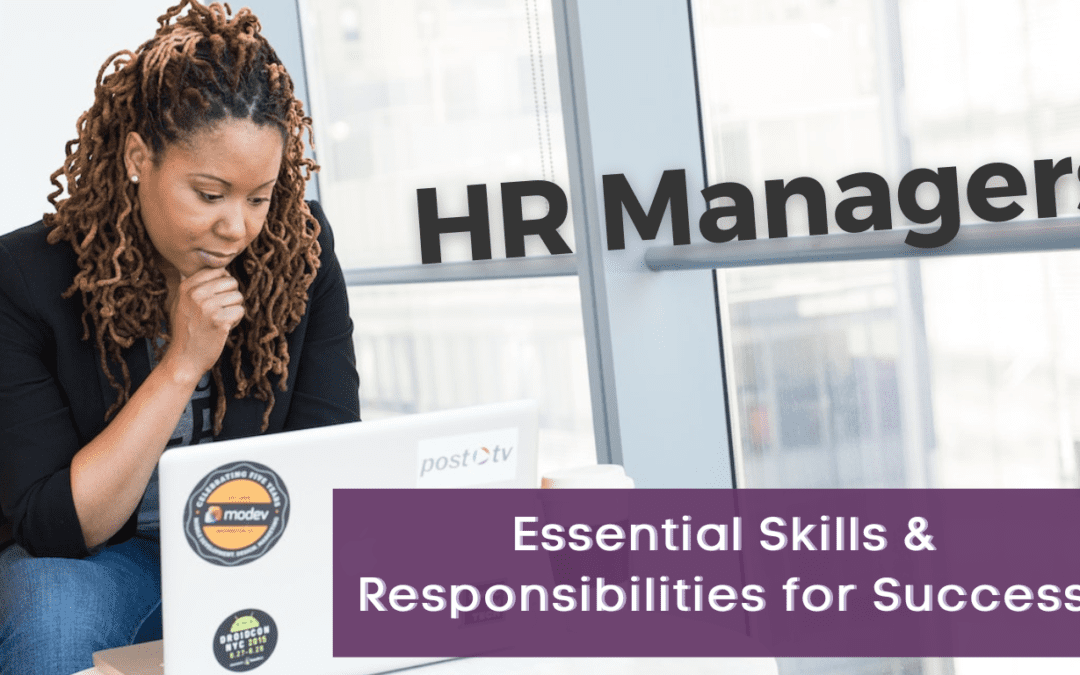In their day-to-day operations, HR Managers often manage various aspects of the employee lifecycle, from hiring and onboarding to professional development and performance reviews. They also play a key role in areas like compensation and benefits administration, ensuring employees are rewarded fairly and in line with industry standards. HR Managers also take care of compliance and legal aspects, making sure the organization abides by employment laws and regulations.
Role and Responsibilities

The various roles an HR Manager performs
As an HR Manager, your role is multifaceted, encompassing a range of duties that contribute to the smooth functioning of a company. These may include aspects of Human Resources Management, such as developing and implementing HR policies and procedures, as well as navigating the complexities of employee relations.
Leadership and Management
A critical component of your role as an HR Manager is providing effective leadership and management. You are responsible for guiding and mentoring your HR team, fostering a positive work environment across the organization, and ensuring that the HR department aligns with the company’s overall strategic goals.
There are tools you can use to keep this in order. The tools I highly suggest are:
- HR Dashboards
- Departmental Dashboards
- Key Performance Indicators (KPIs) or Objectives & Key Results (OKRs)
- HR Scorecards
Employee Relations and Communication
Maintaining positive employee relations and facilitating clear communication are key responsibilities for an HR Manager. This includes addressing employee concerns or grievances, fostering open and transparent communication channels, promoting a healthy work culture, and implementing performance management strategies to drive employee engagement and development. If necessary, HR Managers can have this managed by their Employee Relations Manager.
Recruitment and Hiring Process
One of your most significant duties as an HR Manager is overseeing the entire recruitment and hiring process. Your responsibilities in this area include:
- Developing job descriptions: Crafting accurate and informative job descriptions that outline the specific duties and responsibilities of roles within the company, as well as giving regulated requirements related to minimum physical requirements, pay transparency, etc.
- Advertising job openings: Utilizing various platforms or job boards to promote job vacancies and attract potential candidates.
- Screening applicants: Evaluating resumes and applications to determine which candidates best align with the company’s needs.
- Conducting interviews: Meeting with candidates to assess their skills, experience, and cultural fit.
- Onboarding new employees: Facilitating a smooth onboarding process to ensure new hires feel welcomed, supported, and prepared for success.
By effectively managing these responsibilities, you create a higher chance of helping your organization attract and retain the best talent to foster a productive and positive work atmosphere.
Training and Development
Implementing Training Programs
As an HR Manager, your role in implementing training programs is vital to the success of your organization. First, start by assessing the training needs of your employees. Identify gaps in their knowledge, skills, and abilities. It’s crucial to involve employees in the process and gather their input on proposed training topics.
Once you determine the training needs, design the program content, making sure it’s engaging and relevant. Utilize a variety of formats like workshops, e-learning modules, or on-the-job training. Creating tailored training materials helps ensure the content resonates with your workforce.
Next, schedule and execute the training sessions. Monitor their effectiveness through employee feedback and evaluate the impact on job performance and overall productivity. Adjust the training programs as needed, using data-driven insights (i.e. survey results, test results, on-the-job performance, etc.) to fine-tune the content and delivery.
It is imperative to keep HR’s training focused on law compliance and company-related job requirements. Include department managers, team leads and/or your company training department on job-specific training. My constant reminder is that “HR knows HR and departments know the day-to-day tasks needed to complete the actual job”.
For HR professionals who will work in the HR department under the HR Manager, I typically suggest professional development options through HRCP for their HR-specific micro-credentials/courses and Course Careers for their HR-specific training. Heyyy HR has a Training Manual for HR Professionals that can be used by HR Professionals who are starting their career AND for those who are seasoned in their career.
Professional Development Opportunities
Supporting professional development is another key aspect of your role. Design and offer opportunities to improve employees’ skills, expand their knowledge, and advance their careers. Consider the following options:
- Skill-building workshops: Offer interactive and hands-on sessions to enhance specific technical or soft skills.
- Mentorship programs: Pair experienced staff members with less experienced employees for career guidance and support.
- Certification programs: Encourage and sponsor employees to earn job-related certifications to boost their expertise.
- Internal job rotations: Allow employees to work in different departments to gain broader organizational knowledge and identify new career paths.
By providing meaningful training and development opportunities, you help employees grow and contribute more effectively to your organization’s success. As an HR Manager, strike the right balance to ensure your workforce is equipped with the necessary skills and knowledge to excel in their roles.
To enhance employee retention, these opportunities should be company-sponsored where the organization pays for these opportunities for the employees.
Compensation and Benefits Administration
As an HR manager, it is vital to have an effective compensation and benefits administration strategy. This section outlines key aspects of managing employee compensation and benefits, including salary and payroll processing, health and wellness programs, and retirement and paid time off policies.
Salary and Payroll Processing
Effectively managing salary and payroll processing is crucial to ensuring employees receive accurate and timely pay. You need to regularly review and update payroll systems to accommodate changes in tax laws, employee information, and company policies. Utilize software solutions to efficiently manage payroll and ensure compliance with local regulations. These solutions can be found in nearly all Human Resources Information Systems (HRISs).
Here are some essential components of salary and payroll processing:
- Regularly updating employee information, such as tax withholdings and deductions
- Ensuring accurate calculations of overtime, commissions, and bonuses
- Properly managing deductions for benefits, such as health insurance
- Complying with labor laws and reporting requirements (i.e. making sure to distribute pay stubs to employees for every paycheck, completing specific pay-related forms, managing garnishments effectively, etc.)
Health and Wellness Programs
A key aspect of providing a competitive compensation package is offering health and wellness programs. These programs can attract top talent and improve employee satisfaction, as well as reduce healthcare costs for your organization. Here are some common elements of health and wellness programs:
- Group health insurance plans, offering various levels of coverage and options & maintaining the minimum required benefits
- Flexible spending accounts (FSAs) and health savings accounts (HSAs)
- Wellness initiatives, such as fitness classes, nutrition counseling, or stress management resources
- Employee assistance programs (EAPs) for mental health and work-life balance support
Retirement and Paid Time Off
Tailoring retirement and paid time off policies to suit the needs of your employees is essential for maintaining a satisfied and productive workforce. A well-rounded retirement plan should include both mandatory contributions (such as Social Security) and optional incentives, like employer-sponsored short-term & long-term disability benefits or 401(k) matching programs.
In addition to retirement planning, consider providing an attractive paid time off (PTO) policy. Some elements of PTO to consider include:
- Vacation days based on seniority or company-wide policies
- Sick leave, offering employees time off for illness or medical appointments
- Personal days, allowing employees to address personal matters or emergencies
- Parental leave, for the birth or adoption of a child
- Unlimited flexible time off (FTO) or unlimited paid time off (PTO)
By thoroughly addressing these areas of compensation and benefits administration, you can create a comprehensive total rewards package that meets the needs of your employees and promotes overall satisfaction.
Compliance and Legal Aspects

Understanding Labor Laws
As an HR manager, it’s crucial for you to have a thorough understanding of labor laws to ensure your organization complies with various regulations. Familiarizing yourself with the employment laws that affect HR management can save your company from potential legal issues and lawsuits, while also creating a fair work environment.
Stay up-to-date with the latest labor laws in your country, state, or municipality, as changes to legislation may impact your organization’s policies. These laws may encompass topics such as minimum wage, overtime pay, discrimination, and harassment. Regularly review your company’s policies and update them as necessary to maintain compliance. If you are not confident that you have the bandwidth to maintain this knowledge, then limit your recertification credits to opportunities where labor laws are presented and explained or start regular meetings with your company’s designated employment law attorney.
Managing Health and Safety Regulations
In addition to labor laws, understanding and implementing health and safety regulations are essential responsibilities of an HR manager. Your employees’ well-being should always be one of your top priorities. Stay informed about ongoing health and safety regulations, and make sure your organization adheres to these requirements, such as OSHA guidelines.
Create clear policies and procedures that promote a safe working environment. Some measures to consider include:
- Workplace safety training: Ensure employees are trained to recognize hazards and follow safety procedures.
- Emergency response plans: Develop plans to address potential emergency situations, such as fires or natural disasters.
- Ergonomics: Assess workstations and work processes to minimize the risk of physical strain or injury.
When managing health and safety regulations, communication is vital. Regularly update your employees through designated training on a regular basis including changes to health and safety guidelines, and encourage them to report any concerns or issues. By diligently following health and safety regulations, you can minimize the risk of workplace accidents and create a supportive, safe atmosphere for your employees.
HR Strategy and Metrics
Aligning HR with Business Strategy
To ensure the success of your organization, it’s crucial to align your HR strategy with your business strategy. Begin by understanding your organization’s strategic plan, which consists of its overall goals and objectives. This will help you identify the specific skills and capabilities your workforce needs to achieve these targets. Prioritize your HR initiatives and investments according to these identified needs. This is where an HR Scorecard can be very useful.
Once you have this understanding, you can create a comprehensive HR action plan. This plan should include concrete steps and timelines for achieving desired outcomes, such as hiring, employee retention, or skill development. To track your progress, consider using HR metrics like employee turnover rate and absenteeism rate.
An essential part of aligning HR with business strategy is effective communication. Keep all stakeholders informed about your initiatives and their impact on organizational performance. Use clear, concise language to explain the rationale behind your decisions and their expected outcomes.
Using HR Metrics and Analytics
Monitoring and measuring your HR efforts is crucial for ensuring their effectiveness. HR metrics provide valuable insights into how your HR strategy contributes to the organization’s overall objectives. You can use these metrics to identify areas for improvement, make informed decisions, and track progress over time. This is where HR Dashboards can be very useful.
Here’s a list of essential HR metrics that can help you optimize your HR strategy:
- Cost per Hire: The total amount spent on talent acquisition, including advertising, interviews, and background checks, divided by the number of hires.
- Time to Hire: The duration between the job posting and the new employee’s start date.
- Quality of Hire: A measure of how well new hires perform, using factors like new hire survey results, retention, job performance, and cultural fit.
- Employee Net Promoter Score (eNPS): A metric that gauges employee satisfaction and loyalty.
- Employee Growth Rate: The ratio of internal promotions and lateral moves to the overall employee population.
To make the most of these metrics, you must effectively analyze the data. Use industry benchmarks and historical trends to analyze and contextualize your findings and identify areas that require attention. If necessary, adjust your HR strategy to better align with your organization’s goals and objectives. If the HR Manager does not have the bandwidth for this, then having an HR Analyst on the HR team can be very beneficial.
Key Takeaways
- HR Managers are responsible for managing an organization’s human capital and/or employees and aligning it with company goals.
- A core aspect involves overseeing the employee lifecycle, from recruitment to development and performance management to retirement or separation/termination.
- Their role also includes compensation and benefits administration, as well as ensuring legal compliance in employment matters.
Frequently Asked Questions (FAQs)
What are the essential qualities one should possess for success in HR management?
To succeed as an HR manager, you should possess a combination of skills and personal qualities. Some of these are:
- Strong communication skills: As an HR manager, you’ll need to interact with employees at all levels, making it crucial to listen, understand, and communicate effectively. Emotional intelligence and diversity, equity, and inclusion (DEI) knowledge can be very useful.
- Problem-solving skills: Being able to identify and resolve employee-related issues is an essential part of your role.
- Adaptability: The world of human resources is constantly evolving, so it’s essential to stay up-to-date with changes in policies, regulations, and best practices.
- Leadership skills: You’ll need to guide your HR team and work closely with the management team to develop and implement strategies, making strong leadership skills a must.
- Organizational skills: Managing multiple tasks and projects is a key component of the job, so being able to prioritize and maintain focus is crucial.
By focusing on developing these qualities, you’ll be well on your way to achieving success in HR management.
Could you provide examples of effective HR Manager advertisements or job listings?
Crafting an effective job listing for an HR Manager position requires a clear, concise, and engaging message that highlights the necessary qualifications, experience, and responsibilities. Here are two examples to consider for your own HR Manager advertisements.
Example 1: Dynamic HR Manager for Growing Tech Company
Join our innovative tech firm as an HR Manager and help us build a world-class team! We’re looking for a seasoned professional with a track record of implementing HR projects and strategies that increase employee satisfaction and drive organizational success.
Key responsibilities:
- Develop and execute talent acquisition strategies
- Manage compensation, benefits, and performance management systems
- Ensure compliance with relevant laws and regulations
Requirements:
- Bachelor’s degree in HR, Business Administration, or related field
- 5+ years of experience in HR management
- Proven experience leading HR projects from inception to conclusion
Example 2: Strategic HR Manager for Cutting-edge Manufacturing Facility
Our leading-edge manufacturing company is seeking an experienced HR Manager to create a collaborative and inclusive workplace culture. This role requires a deep understanding of HR best practices, labor laws, and effective recruitment strategies.
Responsibilities:
- Manage talent acquisition and retention
- Develop and implement training programs
- Assist in the development of HR policies and procedures
Qualifications:
- Bachelor’s degree in a relevant field, or equivalent experience
- 7+ years of experience in HR roles, with at least 3 in a leadership position
- Strong communication and problem-solving skills
These examples provide a solid foundation for creating your own engaging and effective HR Manager advertisements, but use this only as a basis or foundation to start your job description. You should include a company overview and your responsibilities and qualifications should be far more detailed.
Heyyy HR’s HR to HR Pro Career Mentoring has been very helpful to many HR Managers and HR Directors.
You May Also Like:




 Subscribe to my channel
Subscribe to my channel
This blog is a treasure! I love it. Thanks for sharing your nuggets of wisdom, Timeka!!!
Thank sooo much Kim! You’re beyond welcome!💜